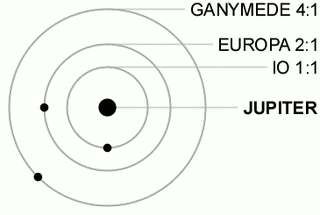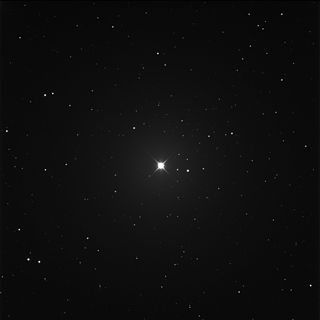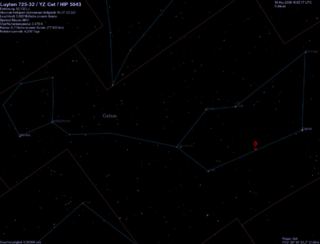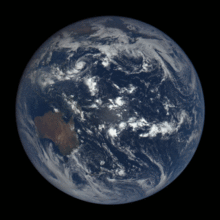
An exoplanet or extrasolar planet is a planet outside the Solar System. The first possible evidence of an exoplanet was noted in 1917 but was not recognized as such. The first confirmation of detection occurred in 1992. A different planet, initially detected in 1988, was confirmed in 2003. As of 1 August 2023, there are 5,484 confirmed exoplanets in 4,047 planetary systems, with 875 systems having more than one planet. The James Webb Space Telescope (JWST) is expected to discover more exoplanets, and also much more about exoplanets, including composition, environmental conditions and potential for life.

In celestial mechanics, orbital resonance occurs when orbiting bodies exert regular, periodic gravitational influence on each other, usually because their orbital periods are related by a ratio of small integers. Most commonly, this relationship is found between a pair of objects. The physical principle behind orbital resonance is similar in concept to pushing a child on a swing, whereby the orbit and the swing both have a natural frequency, and the body doing the "pushing" will act in periodic repetition to have a cumulative effect on the motion. Orbital resonances greatly enhance the mutual gravitational influence of the bodies. In most cases, this results in an unstable interaction, in which the bodies exchange momentum and shift orbits until the resonance no longer exists. Under some circumstances, a resonant system can be self-correcting and thus stable. Examples are the 1:2:4 resonance of Jupiter's moons Ganymede, Europa and Io, and the 2:3 resonance between Neptune and Pluto. Unstable resonances with Saturn's inner moons give rise to gaps in the rings of Saturn. The special case of 1:1 resonance between bodies with similar orbital radii causes large planetary system bodies to eject most other bodies sharing their orbits; this is part of the much more extensive process of clearing the neighbourhood, an effect that is used in the current definition of a planet.

A planet is a large, rounded astronomical body that is neither a star nor its remnant. The best available theory of planet formation is the nebular hypothesis, which posits that an interstellar cloud collapses out of a nebula to create a young protostar orbited by a protoplanetary disk. Planets grow in this disk by the gradual accumulation of material driven by gravity, a process called accretion. The Solar System has at least eight planets: the terrestrial planets Mercury, Venus, Earth and Mars, and the giant planets Jupiter, Saturn, Uranus and Neptune. These planets each rotate around an axis tilted with respect to its orbital pole. All planets of the Solar System other than Mercury possess a considerable atmosphere, and some share such features as ice caps, seasons, volcanism, hurricanes, tectonics, and even hydrology. Apart from Venus and Mars, the Solar System planets generate magnetic fields, and all except Venus and Mercury have natural satellites. The giant planets bear planetary rings, the most prominent being those of Saturn.

Tidal locking between a pair of co-orbiting astronomical bodies occurs when one of the objects reaches a state where there is no longer any net change in its rotation rate over the course of a complete orbit. In the case where a tidally locked body possesses synchronous rotation, the object takes just as long to rotate around its own axis as it does to revolve around its partner. For example, the same side of the Moon always faces the Earth, although there is some variability because the Moon's orbit is not perfectly circular. Usually, only the satellite is tidally locked to the larger body. However, if both the difference in mass between the two bodies and the distance between them are relatively small, each may be tidally locked to the other; this is the case for Pluto and Charon, as well as for Eris and Dysnomia. Alternative names for the tidal locking process are gravitational locking, captured rotation, and spin–orbit locking.

61 Virginis is the Flamsteed designation of a G-type main-sequence star (G7V) slightly less massive than the Sun, located 27.8 light-years away in the constellation of Virgo. The composition of this star is nearly identical to the Sun.

Planetary migration occurs when a planet or other body in orbit around a star interacts with a disk of gas or planetesimals, resulting in the alteration of its orbital parameters, especially its semi-major axis. Planetary migration is the most likely explanation for hot Jupiters. The generally accepted theory of planet formation from a protoplanetary disk predicts that such planets cannot form so close to their stars, as there is insufficient mass at such small radii and the temperature is too high to allow the formation of rocky or icy planetesimals.

54 Piscium is an orange dwarf star approximately 36 light-years away in the constellation of Pisces. In 2003, an extrasolar planet was confirmed to be orbiting the star, and in 2006, a brown dwarf was also discovered orbiting it.

Delta Geminorum, formally named Wasat, is a triple star system in the constellation of Gemini.

YZ Ceti is a red dwarf star in the constellation Cetus. Although it is relatively close to the Sun at just 12 light years, this star cannot be seen with the naked eye. It is classified as a flare star that undergoes intermittent fluctuations in luminosity. YZ Ceti is about 13 percent the mass of the Sun and 17% of its radius.

AD Leonis (Gliese 388) is a red dwarf star. It is located relatively near the Sun, at a distance of 16.2 light-years, in the constellation Leo. AD Leonis is a main sequence star with a spectral classification of M3.5V. It is a flare star that undergoes random increases in luminosity.

Earth's rotation or Earth's spin is the rotation of planet Earth around its own axis, as well as changes in the orientation of the rotation axis in space. Earth rotates eastward, in prograde motion. As viewed from the northern polar star Polaris, Earth turns counterclockwise.

The formation of the Solar System began about 4.6 billion years ago with the gravitational collapse of a small part of a giant molecular cloud. Most of the collapsing mass collected in the center, forming the Sun, while the rest flattened into a protoplanetary disk out of which the planets, moons, asteroids, and other small Solar System bodies formed.
In astronomy, a co-orbital configuration is a configuration of two or more astronomical objects orbiting at the same, or very similar, distance from their primary, i.e. they are in a 1:1 mean-motion resonance..

Retrograde motion in astronomy is, in general, orbital or rotational motion of an object in the direction opposite the rotation of its primary, that is, the central object. It may also describe other motions such as precession or nutation of an object's rotational axis. Prograde or direct motion is more normal motion in the same direction as the primary rotates. However, "retrograde" and "prograde" can also refer to an object other than the primary if so described. The direction of rotation is determined by an inertial frame of reference, such as distant fixed stars.
The five-planet Nice model is a numerical model of the early Solar System that is a revised variation of the Nice model. It begins with five giant planets, the four that exist today plus an additional ice giant between Saturn and Uranus in a chain of mean-motion resonances.
HD 45184 is a star in the southern constellation of Canis Major. It is a yellow-hued star near the lower limit of visibility to the naked eye with an apparent visual magnitude of 6.37. The star is located at a distance of 71.65 light years from the Sun based on parallax. It is drifting closer with a radial velocity of −3.8 km/s.
Gliese 754 is a dim star in the southern constellation of Telescopium. It has an apparent visual magnitude of 12.25, which requires a telescope to view. The star is located at a distance of 19.3 light-years from the Sun based on parallax, and it is drifting further away with a radial velocity of +7 km/s. It is one of the hundred closest stars to the Solar System. Calculations of its orbit around the Milky Way showed that it is eccentric, and indicate that it might be a thick disk object.
HD 167665 is a yellow-white hued star with a brown dwarf companion in the southern constellation of Sagittarius. With an apparent visual magnitude of 6.39, it is near the lower brightness limit for stars that are visible to the naked eye. Based upon an annual parallax shift of 32.4 mas as seen from Earth, it is located 101 light years from the Sun. The star is moving away from the Sun with a radial velocity of +8 km/s.
Gliese 49 is a star in the northern constellation of Cassiopeia. Visually, it is located 106 arcminutes north of the bright star γ Cassiopeiae. With an apparent visual magnitude of 9.56, it is not observable with the naked eye. It is located, based on the reduction of parallax data of Gaia, 32.1 light-years away from the Solar System. The star is drifting closer to the Sun with a radial velocity of −6 km/s.













